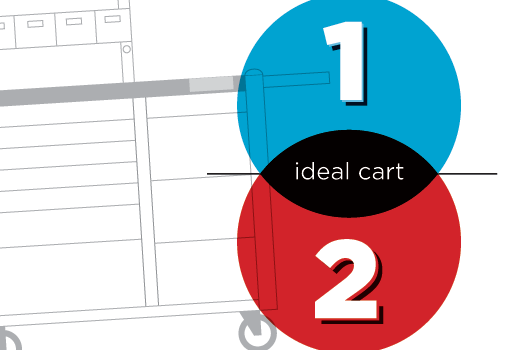How to Choose Your Ideal Mobile Cart Solution

Ideal Mobile Cart Selection Process
Today’s healthcare market offers more options than ever in the world of mobile solutions, AKA: CARTS! Often healthcare professionals ask us how to choose the ideal mobile cart solution. Here is a simple, intelligent and proven way that will help you determine the best solution for your specific cart application.
American River Medical uses an intelligent two-stage process; “Primary” and “Secondary”. It is natural for one to look for the features they think they want, and then ask if they match the benefits they were seeking. By using this traditional method, many times the benefits are not clearly defined. Our team advocates to actually work backward! After all, the benefits you need and want are actually more important. They represent the advantage the specific feature gives you.
Here is how our Ideal Mobile Cart Primary Stage works. 1-2-3!
Step 1: What are the specific storage items targeted for the mobile solution/s?
Take the items to be stored and lay them out. Decide which items belong together. Categorize and configure them as they will be stored, drawer by drawer. Use a tape measure to measure the newly grouped products. Now reconcile these groups into drawer depth heights of 3″, 6″, 9″ or 12″.
NOTE: Most carts have either 24″ or 30″ of total vertical drawer space. Depending on cart application the user may be able to store additional items via accessory storage (tilt bins, baskets, etc.) or on top of the cart top itself.
Step 2: Identify the carts home or path of travel.
Will this cart be stationary (patient’s room, OR, vestibule of the ED)? Or will it have a path of travel? Many times carts travel from a point of stocking to a point of use. Perhaps the cart is being stocked in pharmacy and traveling to a medication room on a different floor. An IV cart will often account for more than one room in the department and therefore be mobile. Whether it is a stationary or mobility cart solution, it will have a place of purpose. Whether at the point of care or in a secured environment for the highly improbable disaster, its place of purpose has a footprint and 3-dimensional space. Assure the adequate room for the entire cart (Height, Width, Depth and don’t forget to leave accessories such as push-handle- shelving-charting tables, etc.).
Step 3: Who will be accessing the mobile cart?
Identify the individuals or groups of staff and physicians that will require access. This is very important. Remember there may be separate staff stocking the cart regularly or irregularly that may need access beyond the staff of intended use. Ask colleagues if they foresee another department needing access for any reason?
After you have identified the above, then you can move to the Secondary Stage where we answer the HOW.
Here is how our Ideal Mobile Cart Secondary Stage works: A-B-C!
Step A: Consider Step 1.
Do the items easily fit into a regular width cart? Could you possibly save some extremely valuable foot-space by using a narrow cart? Will the items fit easily into a vertical drawer configuration totaling 30″? Determine the preferred and acceptable cart height and widths. Prices will almost always invariably differ. If you know the dimensions you prefer, you may evaluate the potential savings justification of a smaller but adequate cart.
Step B: Consider Step 2.
If the cart is stationary, you may consider aesthetics as much as quality. Conversely, if your cart has a path of travel, an emphasis on overall cart durability and warranty are far more prudent than aesthetics. Steel boot casters would be an example of a durability feature desired for a mobile solution with a path of travel. If the cart is going to be mobile, durability, quality, and warranty will all be worthwhile proactive considerations over the 5-10+ year life of the cart. These proactive considerations will save you headaches and valuable time in the future.
Step C: Consider Step 3.
Now that you have and identified group of users, and the potential security access levels, you are ready to assess which locking mechanism is right for you. The majority of cart manufacturers offer key, mechanical push-button, or electronic numeric keypad options. Most really good manufacturers offer LCD, mag-stripe, biometric, RFID and proximity access technologies. Proximity card access is the hottest trend today in cart access due to it’s ability to interface with existing badge credentials, non-touch use, and very low margin for error or malfunction. A “Crash” or other “Emergency” type access cart suggests a break-away flap is ideal. This allows it to be visually secure, ensuring tamper proof contents at critical time of access.
Use these simple primary and secondary steps to get the ideal mobile cart for the right application every time.
When in doubt contact a Rep! You can easily do this via email or phone and they can prove to be an invaluable resource to work on your behalf. Most representatives or territory managers will jump at the chance, and may offer unknown options or applications as well as preferred pricing.
American River Medical Founder Tagg Neal is a Veteran of the medical cart industry and Your Trusted Cart Advocate. American River Medical is the authorized Representative for S&S MedCart in the western United States. He can be reached at: tneal@americanrivermedical.com

